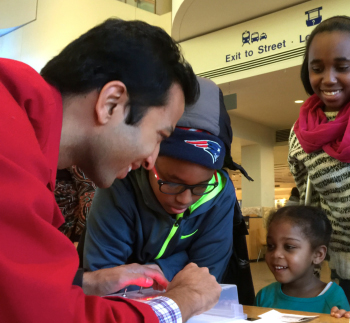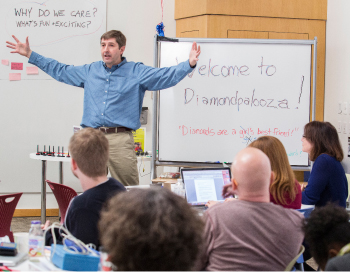Quantum Coherence: Partnering Beyond Nano
This article was written by Carol Lynn Alpert, Director, Strategic Projects, Museum of Science, Boston, and co-director of the NSF Center for Integrated Quantum Materials (NSF-DMR 1231319) headquartered at Harvard University.
As one of the founders of the Nanoscale Informal Science Education Network, I’ve spent the past ten years encouraging science museum folks to partner with nearby university research centers to produce innovative audience engagement experiences in frontier areas of investigation. Instead of competing for the rather petite pot of funding available nationally for informal science, we could be sharing a cornucopia of creative ISE experiences produced via contracts and sub-awards through federally-funded research nodes in our own communities. It’s a terrific way to cull together resources for broader impact. (I wrote a guide on how to do this, called “A Guide to Building Partnerships between Science museums and University-Based Research Centers.”)
Our first million-dollar ten-year subaward collaboration, with the NSF Nanoscale Science and Engineering Center headquartered at Harvard, launched in 2001, and was soon followed by partnership with the NSF Center for High-rate Nanomanufacturing (CHN) based at Northeastern. Since then, the Strategic Projects Group at the Museum of Science has enjoyed more than a dozen collaborations with centers and individual investigators. They’ve been wildly productive. The bulk of the sub-award supports staff time rather than exhibit construction, and that means we’ve been able to explore a sweep of creative approaches—from big “meet the researcher” events with demos and presentations, to television science news stories, a YouTube channel, podcasts, and symposia for journalists and educators. In collaboration with the two nano Centers we’ve produced more than 2300 Museum presentations reaching more than 81,000 people, along with the remarkably successful Amazing Nano Brothers Juggling Show which has reached more than 75,000 people at MOS and through travelling school performances; the Talking Nano DVD set (over 1,100 copies delivered to schools and museums), and the NanoNerds YouTube channel (1,175 subscribers). This spring we complete our work with CHN by premiering a new 15-minute film on nano-manufacturing.

MIT grad student Sumit Dutta tests out a prototype of his computer
logic activity with MOS visitors. Interpreting next-generation computing
will be more challenging.
Going Quantum
The Harvard Nanoscale Science & Engineering Center rode its tiny stallion into the NSF funding sunset in 2012, but has since been replaced by a new NSF Science-Technology Center, the Center for Integrated Quantum Materials, or CIQM, a partnership between Harvard, MIT, Howard University, and MOS. Fellow ISE folks, if you think nano was a hard nut for us to crack for family audiences, try this: two-dimensional materials, diamond nitrogen-vacancy centers, and topological insulators. Oh my. We find ourselves challenged to interpret electron spin, wave functions, coherence, entanglement, and quantum superposition, with applications ranging from quantum cryptography to single atom sensors and detectors. (Anyone out there done an exhibit/activity on this? If so, please contact me...)
We couldn’t have a better set of partners—the quantum materials researchers at Harvard, MIT, and Howard University represent some of the top people in the world in these areas, and they sincerely believe in the importance of education, outreach, and engagement. One of our strategies is to include them in big visualization and education brainstorming workshops, along with artists and educators, graduate and undergraduate students. We held our first in mid-January, and nicknamed it “Diamondpalooza” because we focused on the sudden worldwide rise of scientific interest in diamond "nitrogen-vacancy centers” created by the substitution of single nitrogen atoms for pairs of carbon atoms within a nano diamond crystal lattice. Just recently discovered, these NV centers act like “artificial atoms” and have the extraordinary ability to hold a “qubit” of information in their direction of “spin” at room temperature. (A qubit is the quantum equivalent of a computer “bit” and offers much more powerful computing and cryptographic possibilities.) Conveniently, the NV centers emit beams of red photons that can serve as “read-outs” of their current spin states. These extraordinary materials are already being synthesized and tested as exquisitely sensitive magnetometers in medical devices and as memory arrays for the quantum computers of the future.
All-Hands, All-Minds
Diamondpalooza ran two days, including research, art, and design talks; a special reception across the street at the Harvard Museum of Natural History with the curator of the university’s historically-significant diamond collection; diamond-shaped helium balloons, a diamondpalooza soundtrack assembled from iTunes; lots of brainstorming, white boards and sticky notes. The feedback survey showed that the scientists had the most fun learning from the artists, educators, and filmmakers (we had David Macaulay, the MacArthur genius author and illustrator, Larry Klein, Emmy Award-winning NOVA producer, NOVA senior science editor Evan Hadingham, and our own fabulous MOS science presenter, Karine Thate). One of the researchers wrote: “It was entertaining and eye opening to have a glimpse into the mind of how people outside of the field think about what we do.”
The artist/filmmaker/educator attendees felt they made headway in understanding synthetic manufacture of diamond NV center arrays and the extraordinary quantum computing and sensing tasks to which they may be applied, but also felt deluged with technical terms and symbols they needed more bandwith to comprehend within a 36-hour period. Aptly, one of the white boards devoted to collecting “Glossary” items requiring simple explanations and diagrams, filled most quickly. But the two white boards labeled “Ideas for Illustrations and Animations” and “Ideas for Props and Demos” also filled quickly, with the grad students contributing a lot of the action. The “Why Do We Care?” white board lagged behind a bit, until filmmaker Larry Klein made an impassioned plea for “hooking” the audience with an application or story.

A Diamondpalooza participant, Harvard researcher Ron Walsworth builds tiny
magnetometers for biomedical research using diamond NV centers.
Many of the grad students commented on the tips they picked up about communicating their research to others: “It is important to keep the audience in mind and make sure key ideas are explained well before going into details”; “…Wisely choose what is essential to the talk and what can be omitted”; and “Clearly stat[e] the challenge and motivation at the beginning and let...the audience try to think about it before giving the answer.”
Students also commented on the less obvious benefits: “…when you are forced to explain something in many different ways, you yourself end up with a much better understanding!… it is as simple as making a connection between two different concepts in my head that probably wouldn't have happened if the questions never came up the way they did.” And, “I'm very glad I attended! It was not only a great opportunity to learn from peers in the field, but it also provided an important big-picture perspective. This is easily lost in the day-to-day lab work.”
An enthusiastic but weary David Macaulay said, later that week, “The event was both overwhelming, fascinating, and without a doubt useful. Watching two of the scientists draw and at the same time discover things they didn't understand was great. It is precisely the right process for figuring out what the key problems are.” Macaulay, well-known for his illustrated books on The Way Things Work and many architectural books like Castle and Cathedral, also noted, “The most interesting thing to me and probably the least useful for communicating what this stuff does or can do, was becoming more familiar with the architecture of this technology. I love seeing how those [nano diamond] columns were actually made for instance and getting a better sense of the structure of carbon and diamonds. Of course there is nothing to say that this stuff can't be communicated more engagingly through animation. I just like to know how things are made as you know…. Small pencils at the ready.”
Outcomes
Diamondpalooza yielded many good ideas for hands-on demos, animations, illustrations, presentations, and high school physics labs, as well as a slew of offers to help with their development. We’ll be testing out some initial concepts at this year’s NanoDays event, where Marko Loncar, one of the Diamondpalooza research participants, will be giving a brief talk, and many of the Center’s students will be testing out their new inquiry-based learning skills, acquired during one of our other workshops, Sharing Science.
More importantly, we found an excellent way to pursue two of our key objectives in these collaborations with university researchers: enlisting their help in the challenge of connecting complex science with broader audiences, and giving them insight into how they can better communicate their science to broader audiences and to each other.